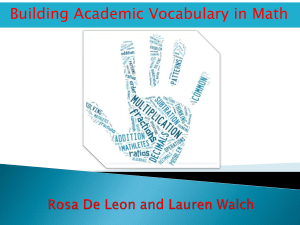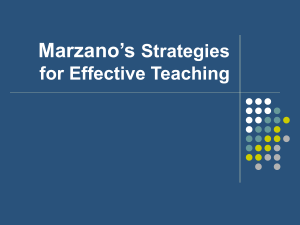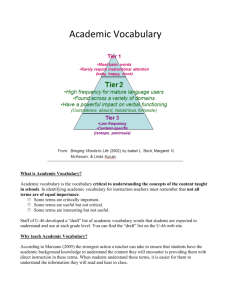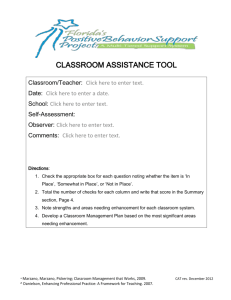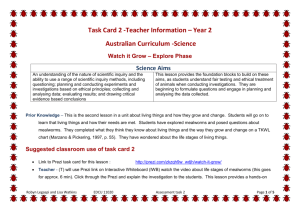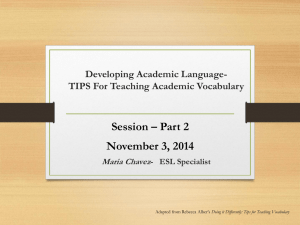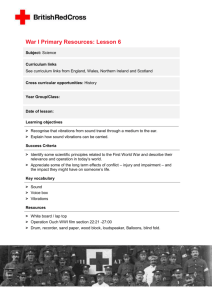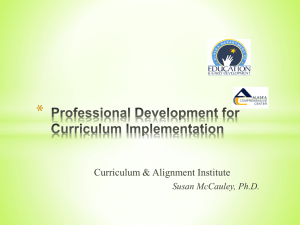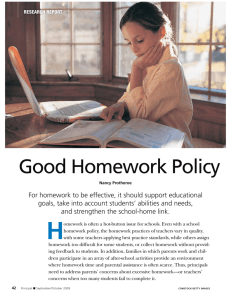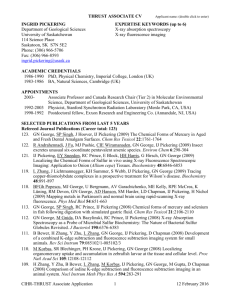Teacher Information - Science Curriculum and Pedagogy task 2
advertisement
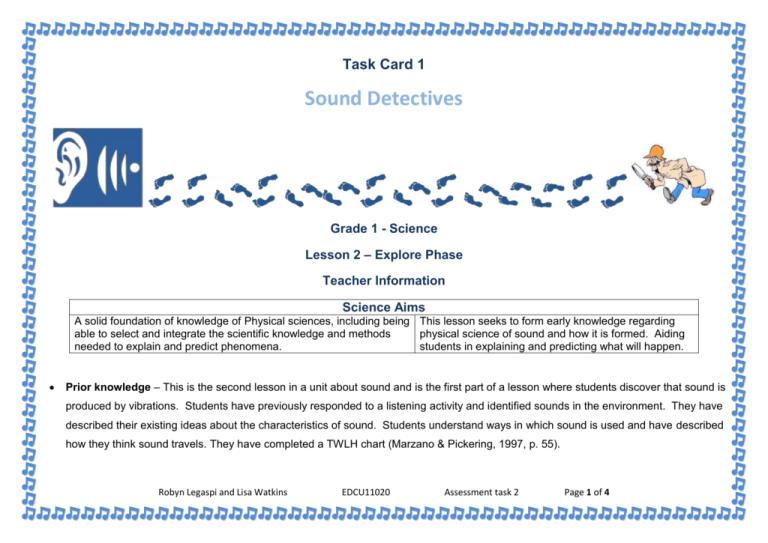
Task Card 1 Sound Detectives Grade 1 - Science Lesson 2 – Explore Phase Teacher Information Science Aims A solid foundation of knowledge of Physical sciences, including being This lesson seeks to form early knowledge regarding able to select and integrate the scientific knowledge and methods physical science of sound and how it is formed. Aiding needed to explain and predict phenomena. students in explaining and predicting what will happen. Prior knowledge – This is the second lesson in a unit about sound and is the first part of a lesson where students discover that sound is produced by vibrations. Students have previously responded to a listening activity and identified sounds in the environment. They have described their existing ideas about the characteristics of sound. Students understand ways in which sound is used and have described how they think sound travels. They have completed a TWLH chart (Marzano & Pickering, 1997, p. 55). Robyn Legaspi and Lisa Watkins EDCU11020 Assessment task 2 Page 1 of 4 Resource list – is provided below. Task card may be printed or projected on IWB. Prior to class, have balloons blown up, one per class pair. Individual science journals should be headed up with the following three sentence starters: Today we… Something I learned was… I would like to know more about…. Suggested classroom use of task card 1 Students should move into science pairs (these have been previously selected by the teacher for students to work well together) (Marzano & Pickering, 1997, p. 20) Review prior knowledge referring to the word wall and TWLH chart (Marzano & Pickering, 1997, p. 55). Students will work scientifically to discover that sound is made by vibrations. Initially they will sing a song ‘This Old Man’ is suggested and the link to a You tube clip of it is linked here. http://www.youtube.com/watch?v=4so4oRkREuk Sing the song and show students how to place their hand on their throat to feel the vibrations, they may be interested to feel someone else’s throat vibrating as well. (Care should be taken) (Marzano & Pickering, 1997, p. 262) Discuss the term vibrate and vibrations and write on the word wall. Students may understand this concept better if it is drawn in wavy lines for them to imagine how it might look. Pass out one balloon per pair Allow one student to hold the balloon and the other to talk quietly onto the balloon. What do they hear? What do they feel? (Marzano & Pickering, 1997, p. 56) IMPORTANT! Check if anyone in the class is allergic to rubber prior to lesson. Do not blow balloons up fully so they do not burst. Robyn Legaspi and Lisa Watkins EDCU11020 Assessment task 2 Page 2 of 4 Ensure students are talking quietly onto the balloon, and that the balloon is not to be held near someone’s ear (Marzano & Pickering, 1997, p. 31). Give students time to have a few turns each. Model completing sentence starters in the class science journal (Marzano & Pickering, 1997, p. 94) Ask students to write their own science journal entry using the headings in their science journal Add new information to the third column of the TWLH chart. Allow students to ask further questions, record these questions in the class science journal. New Words: Vibrate, Vibration Follow up lessons – Next lesson students will investigate the vibrations made by percussion instruments. Students will explore loud and soft sounds. Assessment opportunities Formative assessment Is ongoing throughout the explore phase of the unit. Students’ understanding is monitored as it develops. Feedback extends their learning Resource Checklist Task Card one per group IPOD and Speakers with backing track for This Old Man http://www.youtube.com/watch?v=4so4oRkREuk TWLH Chart – in Class Science Journal Balloons – one per pair and some spares Individual Science Journals with pre-written sentence starters Robyn Legaspi and Lisa Watkins EDCU11020 Assessment task 2 Page 3 of 4 Declarative Knowledge Know that sound is produced from vibrations Procedural Knowledge Understand that they can feel the vibrations of sound as it is produced in our throat. Links to Australian Curriculum Strand Sub-Strand Content Descriptors General capabilities Science Understanding Physical sciences Science journal entries literacy Science as Human Endeavour Nature and development of science Questioning and predicting Sound is produced by a range of sources and can be sensed Science involves asking questions about, and describing changes in objects Respond to and pose questions, and make predictions about familiar objects Class discussion Critical thinking Teamwork Personal and social competence Science Inquiry Skills DOL Focus DOL 1 Structure opportunities for students to work with peers Use a variety of ways to engage students in classroom task DOL 2 Construct model – model/construct steps DOL 5 Restrain impulsivity Inquiry learning Robyn Legaspi and Lisa Watkins EDCU11020 Assessment task 2 Page 4 of 4
